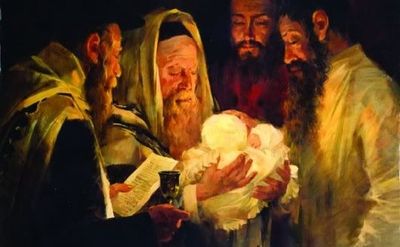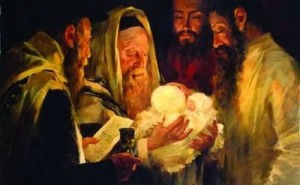 One more mazel tov shout out to our friends Doba and Kalman Isaacs upon the arrival and naming of granddaughter Sarit Isaacs, born to their children Sharona and Yehuda Isaacs. May Sarit be a source of nachas to both extended families.
One more mazel tov shout out to our friends Doba and Kalman Isaacs upon the arrival and naming of granddaughter Sarit Isaacs, born to their children Sharona and Yehuda Isaacs. May Sarit be a source of nachas to both extended families.
Raboyseyee and Ladies:
Whodunit?
We begin here: last shabbis, during davening mamish, a reader walked over and lodged a complaint. He said: the Oisvorfer wrote something that may not be emes. Oy vey! Tell me more I said and he responded azoy: The Oisvorfer, while discussing the beauty of Soro, wrote “Says the Gemora (Sanhedrin 39b): even Avishag, one of Dovid’s 18 wives, was not half as beautiful as was Soro. The words “one of Dovid’s 18 wives” were mine. Said long time reader Jonathan Herschberg, azoy: it’s not emes: Avishag was not married to Dovid Hamelech (King David)! The Oisvorfer responded by suggesting that he would further research the matter and he has. The bottom line: Jonathan was (efsher) half-right. Whether or not Dovid did, or did not marry, did or did not have sexual relations with 12-year-old Avishag, is very hotly debated in the heylige Gemora and in many other places. Pages can be filled on this topic alone; a good study of Dovid Hamelech, his life and exploits, would require an entire book. The Oisvorfer may be involved in a book on Dovid, details to follow. The Novee does not explicitly tell us that he was, or was not married to her. The Novee does tell us that Avishag was brought in to warm-up the bed of an older Dovid. According to the narrative, Dovid’s servants searched, found , and gave him Avishag as a maidservant to “keep him warm.” A concubine. Ober let’s get real: a maidservant is a shtikel gilecther (ridiculous way) of keeping Dovid warm when they could have just as well given him more blankets, and or, placed him near a better fire. Although the text isn’t explicit about this, it’s fairly obvious that Avishag was given to Dovid in the hopes of birthing another son who would be a clear choice to be the next king, one the nation could rally behind. Many then assume that her bed-warming duty also included relations and some suggest that by inference, he did marry her. Of course, others suggest that though she was sent in to warm the bed, the real mission was an emission, if you chap, to produce an heir before it was decided that Shlomo was to succeed Dovid. In other words: the mission and efsher the emission, both failed! The real emes: though our sages struggle valiantly through various interpretative machinations to chap what Dovid was trying to, if you chap, and avada worked indefatigably to paint Dovid to have been as pure as the driven snow. Ober, not a one knows with certainty what, if anything, went down. His relationship with Avishag raises many questions, chief among them, was the relationship sexual? Did he marry Avishag? And, if so, was the marriage consummated? Shlomo’s response to Adoniyohu’s request to marry her, suggests that Dovid did indeed wed Avishag. The bottom line: we all know that Dovid was a tzadik, of course; except when he wasn’t. Aren’t we all? And as the Oisvorfer has told you over and again: it’s avada good to be the king.
Nu, since we mentioned Dovid, let’s quote Rashi and it’s vichtig (critical)) that you read the brackets, and his words in their entirety on the heylige Gemora (Sanhedrin 22A), where he says azoy:
אמר רב שמן בר אבא בוא וראה כמה קשין גירושין שהרי דוד המלך התירו לו לייחד [עם אבישג ואע”פ שנאסר ייחוד ש
ל פנויה] ולא התירו לו לגרש [אחת מי”ח וישאנה]
And in English: R’ Shaman bar Aba said: Come and see how harsh divorce is. They gave permission to King David to be alone [with Avishag, even though it was forbidden to be alone with an unmarried woman], but did not let him divorce [one of his 18 wives to marry her].
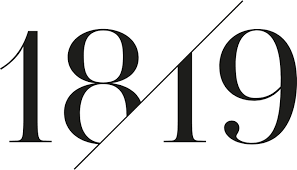 In other words: according to this Rashi, Dovid was able to spend alone-time- with her despite already having 18 wives. He got special dispensation from the rabbis of his generation. As to weekly reader Jonathan: if Dovid was married to Avishag, she did not count as one of the 18; she would have been #19. Let’s learn some parsha.
In other words: according to this Rashi, Dovid was able to spend alone-time- with her despite already having 18 wives. He got special dispensation from the rabbis of his generation. As to weekly reader Jonathan: if Dovid was married to Avishag, she did not count as one of the 18; she would have been #19. Let’s learn some parsha.
Chances are nebech good that you walked out of shul this past shabbis before the laining was over, and that you missed the last aliya (reading of the parsha). Had you remained, you would have read of the first ever bris recorded in the heylige Toirah. Let’s go back and start there: At the age of 99, the RBSO explicitly instructed Avrohom to undergo a bris, to remove the foreskin from his member (penis). The heylige Toirah tells us that of course Avrohom listened to the RBSO and then goes on to tell us that on that very day, not just did Avrohom have a bris performed but also his son Yishmoale. And if that weren’t enough work for one day, many others, seemingly eager to join the Ivri movement and become Yiddin, among its first members, had their own members somewhat reduced. Says the heylige Toirah: “..and all the people of his household, born in his household, and purchased for money from a stranger, were circumcised.” It was a mass bris ceremony. Foreskins were flying. Mamish?
Speaking of flying foreskins, which you mistama thought was but a bad joke from the less than heylige Oisvorfer, says the medrish 47:7: Rabbi Ayvu said, “When Avrohom circumcised the males of his household, they made a pile of foreskins. The sun shone upon them and they putrefied. Their odor went up to The RBSO just like the incense and the burnt offering (the korban oilah), which is totally consumed by the fire. The RBSO said, ‘When their children sin and perform wicked acts, I will recall this smell for them, and I will be filled with mercy for them, and I will act mercifully.’ “And for that reasons alone, and zicher many more, the Oisvorfer just loves digging up medroshim; there was no limit to their ingenuity and imagination. Who knew that the scent of burning foreskins could so please the RBSO? Only the medrish!
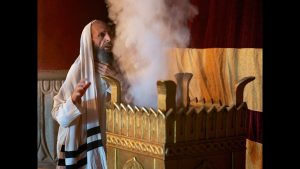 Ober, who performed all these brissim? The heylige Toirah does not tells us. Not to worry, we shall address that below. What Rashi, does tell us -based on the particular wording of the heylige Toirah, is this: it’s taka emes that Yishmoale, the slaves and others in the Avrohom household underwent circumcisions that day, ober not necessarily Avrohom? Avrohom didn’t have a bris? Is that emes? Not exactly! Says Rashi and avada the Oisvorfer quotes verbatim, azoy “because all Avrohom was lacking was the cutting of the flesh of the foreskin, for it had already been compressed through intercourse.” Rashi says what? Avrohom’s foreskin had become compressed, whatever that means!? And Rashi knew just how much intercourse Avrohom had experienced? And Rashi says this why? Because the words in the heylige Toirah state “when he was circumcised by the flesh of his foreskin,” such wording is meant to tell us that all Avrohom needed was a cut of his foreskin for it –as a result of intercourse over his 99 years- had already flattened out the foreskin. Is that what happens? Ver veyst. In any event, that’s how Parshas Lech Lecha came to an end.
Ober, who performed all these brissim? The heylige Toirah does not tells us. Not to worry, we shall address that below. What Rashi, does tell us -based on the particular wording of the heylige Toirah, is this: it’s taka emes that Yishmoale, the slaves and others in the Avrohom household underwent circumcisions that day, ober not necessarily Avrohom? Avrohom didn’t have a bris? Is that emes? Not exactly! Says Rashi and avada the Oisvorfer quotes verbatim, azoy “because all Avrohom was lacking was the cutting of the flesh of the foreskin, for it had already been compressed through intercourse.” Rashi says what? Avrohom’s foreskin had become compressed, whatever that means!? And Rashi knew just how much intercourse Avrohom had experienced? And Rashi says this why? Because the words in the heylige Toirah state “when he was circumcised by the flesh of his foreskin,” such wording is meant to tell us that all Avrohom needed was a cut of his foreskin for it –as a result of intercourse over his 99 years- had already flattened out the foreskin. Is that what happens? Ver veyst. In any event, that’s how Parshas Lech Lecha came to an end.
Welcome to parshas Vayero where, as the parsha opens, the very first words of the first verse tell us that it’s the third day following the procedure and Avrohom is resting under a tree when the RBSO makes a house call to visit a recuperating 99 year old Avrohom. Where specifically was this tree? Where was he? Says the heylige Toirah (Bereishis 18:1): “And HaShem appeared to him [Avrohom] in the Plains of Mamray and he sat in the opening of his tent in the hottest part of the day.”
And before we get to the “plains of Mamray,” what they were, where they were, and if Mamray was a place or a person, let’s begin with a question left open as Lech Lecha came to an end. Did we answer the question of who performed all these brissim? We did not! Did Avrohom self-circumcise? Was he trained as a moiel? How did he know where and what to cut? How much to lob off? Did the RBSO appoint someone to do the cutting? Let’s recall that when it came time to build the Mishkan, the RBSO did imbue Betzalel with special gifts of understanding and wisdom, and then appointed him as the general contractor. Was anyone so trained and then appointed to perform the brissim of Avrohom and his entire household? Let’s see what a few had to say: Avada we chap that once the RBSO appeared (Bereishis 17:1) and said to Avrohom “I am Keil Shakkai. Walk before Me and be perfect,” Avrohom was going to conform. He was a believer, efsher the first real one.
Says Pirkei D’Rebbi Eliezer 29 as does Toisfis in the heylige Gemora (Rosh Hashono 11A) azoy: Avrohom’s bris took place on Yom Kippur. Of course there was no Yom Kippur back then, ober let’s roll with the medrish and Toisfis; why should the fact that Yom Kippur did not yet exist get in the way of a good pshat? Moreover, of course our zeyda kept the entire Toirah though it wasn’t to be revealed until for a few hundred more years. In any event, whether he kept the Toirah or not, or whether the bris was on Yom Kippur, ver veyst. Still he says azoy. Since it was a Yom Kippur bris, incidentally a topic the Oisvorfer knows well, as the bris of his oldest boy was taka on Yom Kippur, azoy: since the bris was on was to be performed on Yom Kippur, Avrohom did not want to perform the milah (circumcision) himself. Why not? Because the bris might violate the laws of Yom Kippur. How so? One may only perform a bris on Shabbos or Yom Tov only if the bris is bizman, on the eighth day. Cleary, at 99, the eighth day was 99 years in the rear view mirror. Accordingly, his bris, though commanded by the RBSO, could not be performed on Yom Kippur. What to do? Enter Shaim, the son of Noiach who did not keep the heylige Toirah. Why not? Because he wasn’t Jewish! Shoin we said it and case solved: Shaim the goy was suddenly available for bris duty. Avrohom asked and Shaim, acted as the first Moiel. Gishmak? But emes? Ver veyst? Let’s not forget that our midrashic exegetes had very vivid imaginations. Ober asks the Oisvorfer azoy: Shaim Ben Noiach performed Avrohom’s bris? How was that shayich (remotely possible)? Wasn’t he the Rosh (headmaster) of a world famous yeshiva known as Shaim Vo’eyver? Are we to believe that he took a day off from running his famous but efsher mythical yeshiva of Shaim and Eyver to perform a bris? OMG! Nu, let’s not forget that it was Yom Kippur and the yeshiva was mistama closed that day. And this Raboyseyee is why the Oisvorfer loves the medrish so much. There is mamish nothing theses great sages could not imagine or argue. Go prove them wrong; each and every theory they put forth is avada supported by some facts, if not imagination. Of course there are other questions to be asked on this medrish, ober those for another day, and let’s instead read whom others suggested as the mystery moiel.
Says Pirkei D’reb Yishmael: וקרא לשם בן נח ומל את בשר ערלתו של ישמעאל בנו – Shaim did have a moiel gig that day but was only hired to cut Yishmoale, Avrohom’s son, down to size. Grada that makes sense as Avrohom might have been a shtikel weakened following his own surgical procedure. Ober, another version of the same medrish suggests that Shaim ben Noaich performed both Avrohom’s and Yishmoale’s brissim. Who did what to whom? Ver veyst? Maybe none of the above? Let’s go veyter.
Says the Medrish Rabba (Bereishis 49:2): the RBSO Himself was Avrohom’s moiel. The RBSO held Avrohom’s hand and helped him perform the bris. Ober why would we suspect that Avrohom had a helper? Was he at 99, efsher not as steady with his hands? The medrish did not and does not make up mysehs of thin air, of whole cloth. Instead, it looks at the textual makeup and finds creative arguments and theories based on the words in the heylige Toirah text. And in this case, the very words of the posik (Bereishis 17:24) seem to imply that someone else and not Avrohom, performed the bris. The passive language of בהמולו (when he was circumcised), point to outside intervention; a helping hand from above helped get the job done below. What really took place? Avrohom asked the RBSO “who will circumcise me”? G-d replied: you will. Immediately Avrohom took a knife and held his foreskin, and wanted to cut it, but he was afraid because he was old. What did the RBSO do? He reached with His hand and held on together with him, and Avrohom did the cutting. And the medirsh relies on which other words or verse for this joint effort theory? So happens that the words found in our everyday davening also lend a hand to this theory. The very well known posik from our morning prayer sates: “vechorois imoy ha’bris” – and He cut with him the bris. He is the RBSO! Mamish gishmak.
And if that pshat wasn’t creative enough, says the Chida in his sefer, azoy: Avrohom was afraid to circumcise himself. What happened next? A scorpion arrived just on time and circumcised him. Shoin! The Chida does not make this up, instead he brings a hint from the word ‘bi’eh’tzem’ which literally means in the middle, ober to the Chidah, the word hints to the scorpion.
Yet another possibility offered by the medirsh tells us this:: “א”ר לוי מל אברהם אין כתיב כאן אלא נימול בדק את עצמו ומצא עצמו מהול ” Reb Levi said that the Toirah said “nimoil Avrahom” as opposed to “moull Avrohom”, meaning Avrohom checked and saw that his penis was already circumcised. Accordingly, all he needed was a cut to the foreskin.
And the bottom line of this mila whodunit mystery is this: whether Avrohom’s foreskin was flattened out as a result of use or not, we taka don’t know. The list of potential moiel candidates is long, longer than was Avorhom post-mila, if you chap, ober what we do know is this: whether Avrohom eagerly ran to get himself circumcised, or whether, according the another medrish (Tanchuma 3), Avrohom only circumcised himself after consulting with his friend Mamray and others, as parshas Vayero opens, the RBSO Himself came to visit a recuperating Avrohom in the “plains of Mamray.” Who is Mamray? Was he a bris consultant? A medical doctor? A student at Shaim and Ever’s yeshiva? Why would a fearless Avrohom, a person who had experienced and survived a fiery furnace, one who waged war against well armed kings and won, be at all hesitant about a cut on his bris koidesh (zach), if you chap? Was his organ more sacred than his own life? Have we met this Mamray consultant before? Where are the plains of Mamray? Is Mamray a place? Is this Mamray the same place the heylige Toirah mentions last week? Mamray is mentioned in Lech Lecho? Let’s find out. And why would, or did the RBSO appear to Avrohom davka in Mamray? Nu to chap all this, again we turn to medirsh who were themselves baffled by all this and imagined a few different scenarios.
Said Reb Yehuda: ELONEI MAMRAY means, “the plains called ‘Mamray”. Ober, said Reb. Nechemia: “the place of Mamray”. According to Reb Yehudah, Mamray is a place; according to Reb Nechemya, Mamray is a person. The bottom line: it appears that Mamray was both a person and a place. Veyter. This is the third time the heylige Toirah mentions this place with at least one more shout to come. Back in Lech Lecha (13:18), we learned that the Plains of Mamray (Alonei Mamray) were located near Chevron, a city with lots of Jewish history ad hayoim hazeh (until today). Chevron is always in the news. Upon arrival to K’nan (Israel), Aloin Mamray is where Avrohom camped. There he built an altar and offered a korban (sacrifice) to the RBSO. We read again about “Alonei Mamray” in 14:13. A war refugee (according to Rashi, this was Oig Melech Haboshon, a Toirah personality we have covered in the past- see archives www.oisvorfer.com many times. From the battlefront he came and informed Avrohom that his nephew Loit, was captured. It is here that the heylige Toirah states that Avrohom was dwelling in the Plains of Mamray. And we are told that Mamray was an Amorite and that he was a comrade-in-arms of Eshkol and Anar. In addition, we are told that all three of these men were Avrohom’s allies.
Vayero opens with the Bikur Cholim call by the RBSO to Avrohom three days post bris. Immediately we are told that this visit took place – B’Alonei Mamray – in the plains of Mamray. Rashi tell us the reason this is mentioned is because Mamray is the one who gave Avrohom the advice to perform (or undergo) the bris. Ober where have we met Mamray before? In last week’s parsha where we read that Mamray and his two cohorts were allies of Avrohom. Says Rashi (Bereishis 14:13): these guys, having entered into some treaty or agreement with him, were Avrohom’s allies. Alternatively, these three gave Avrohom bris advice. And they were seemingly all good guys. And we know this how? Again says the medrish (Yalkut Shimoni 23): one of the meanings of name of Kiryas Arba, the city of four, a city we will read about next week, is that four tzadikim lived there; Avrohom and his three allies. They also appear peripherally after the Akeydo as Avrohom contemplates having Yitzchok marry one of their daughters. Who are these people and what is their importance? Shoin: if the heylige Toirah which is -so our rabbis teach us- typically succinct with its words and not one word or even letter is extra- mentions this place Mamray three different times and more to come, mistama such shout-outs -as do the Oisvorfer’s- have significance. Why taka did the RBSO davka appear to Avrohom in the plains of Mamray? Says the medrish (Bereshis Rabba 42): He, appeared to Avrohom in the plains of Mamray because Mamray had given Avrohom advice on circumcision. This enabled him to merit that the Shechinah (the RBSO’s Essence) would reveal itself in his field. Ober as we asked above, why would, and did Avrohom seek advice on circumcision? Was Avrohom hesitant? In addition, we must understand why Avrohom sought counsel from three different friends: Aner, Eshkol, and Mamray. Who were these guys? Was the advice unanimous? To chap all this, let’s recall a storyline from last week. Loit was taken captive, Avrohom went to war, got Loit back, and retuned all the booty to the kings who lost the war. The loser kings wanted to reward Avrohom but he refused. Ober Avrohom did not forget his three buddies who accompanied him to war. Said Avrohom (Bereishis 14:24), azoy: “Far from me! only what the young men have eaten and the share of the men who accompanied me, Aner, Eshkol and Mamray- they shall take their share (of the booty).” The bottom line: these three guys bet on Avrohom, and Avrohom remembered to make sure they were taken care of. They had a close personal relationship. Having a few close friends in life is more than givaldig. And now it all makes sense. Said Reb Aristotle: A friend is a single soul dwelling in two bodies.
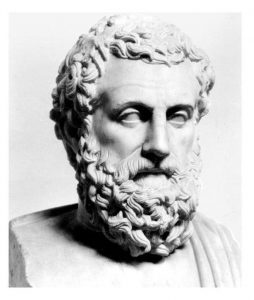 The Medrish Rabbah (42:8) describes a discussion between Avrohom and his three friends. Once commanded to undergo a bris ceremony, Avrohom asked his trusted buddies for advice. Said Aner: you are already one hundred years old, why are you putting yourself in such physical pain. Eshkol said: Why are you making such a differentiation between you and the world around you? Mamray? He said. The RBSO stood by you as your enemies were out to get you, and now you will not do what he wants!? For his good advice, the RBSO elected to visit Avrohom in his fields.
The Medrish Rabbah (42:8) describes a discussion between Avrohom and his three friends. Once commanded to undergo a bris ceremony, Avrohom asked his trusted buddies for advice. Said Aner: you are already one hundred years old, why are you putting yourself in such physical pain. Eshkol said: Why are you making such a differentiation between you and the world around you? Mamray? He said. The RBSO stood by you as your enemies were out to get you, and now you will not do what he wants!? For his good advice, the RBSO elected to visit Avrohom in his fields.
Ober as you can imagine, every medrish has its own spin and one Aggadata tells us that all three buddies also underwent the bris ceremony and then all died. Why were they deserving of death when they came around and gave Avrohom good advice? For those answers, we need to read more medrish, ober those for another day. Ober one quickie answer form the Sfas Emes tells us that their performance as non-Jews of the mitzvah given to Avrohom was an infringement into our special and unique covenant. The performance of this mitzvah by these goyim was the equivalent of adultery. What chutzpah! How dare they? As great as these three goyishe friends of Avrohom were, they had no business messing around with their own place of business, if you chap.
A gittin Shabbis-
The Heylige Oisvorfer Ruv
Yitz Grossman
